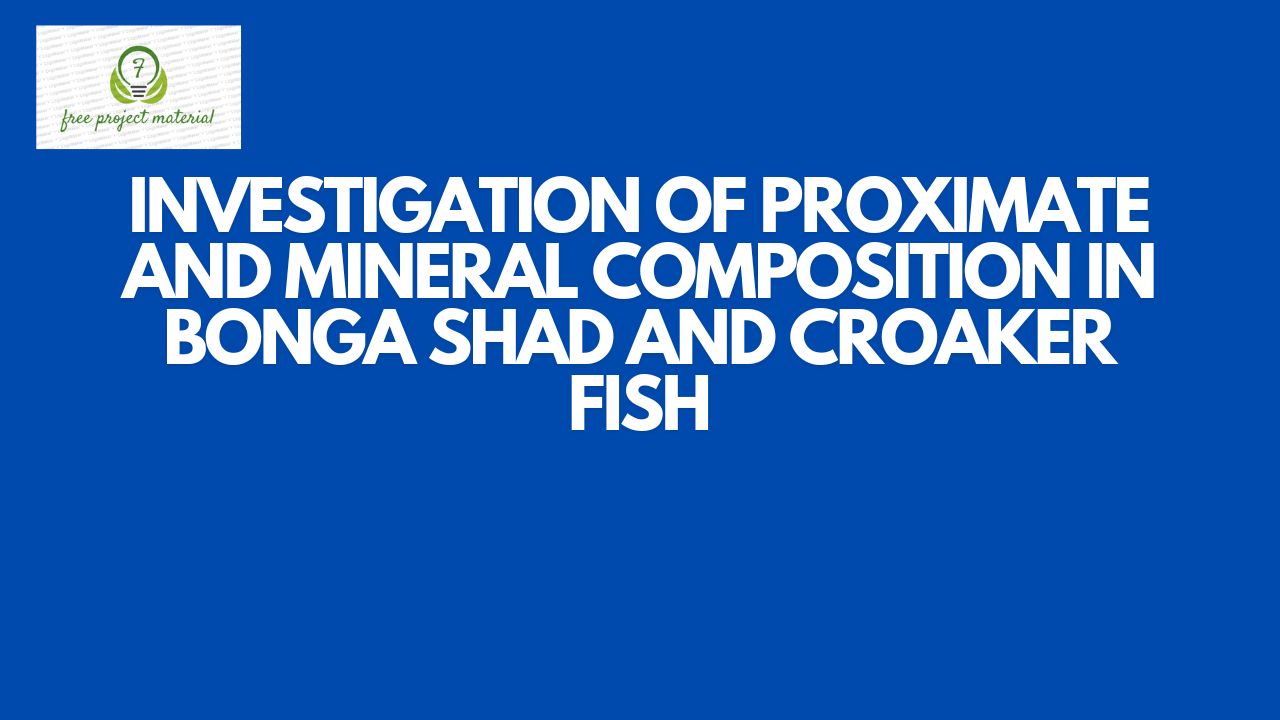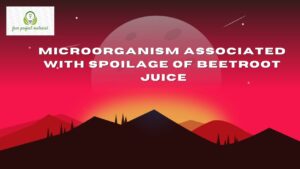ABSTRACT
The aim of this study was to determine the proximate and mineral composition of bonga shad and croaker fish obtained from Esin Ufot beach, Oron. The proximate and minerals composition were determined using standard analytical techniques. The result of the study revealed that Croaker fish recorded for moisture 53.02±0.003%, crude protein (61.30±0.025%), Crude fat (14.54±0.003%), ash (8.47±0.002%), crude fibre (7.08±0.003%), carbohydrate (8.61±0.010%) and caloric value (85.2±0.003kcal). Bonga fish had for moisture (54.84±0.004%), crude protein (58.50±0.030%), crude fat (12.09±0.005%), ash (10.40±0.002), crude fibre (9.23±0.002%), carbohydrate (9.77±0.012%) and caloric value (325.1±0.002kcal). Minerals analysis of Croaker fish revealed the following; nitrogen (64.42±0.44 mg/100g), phosphorus (125.60±0.40 mg/100g), potassium (127.80±0.04 mg/100g), zinc (20.42±0.07 mg/100g) and manganese (1.18±0.21 mg/100g). Bonga fish showed for nitrogen (58.65±0.47), phosphorus (13.40±0.41 mg/100g), potassium (41.20±0.05 mg/100g), zinc (22.41±0.05 mg/100g) and manganese (0.59±0.05 mg/100g). This result indicate that the fish species are good sources of mineral and its consumption would help prevent nutritional deficiencies in humans and other consumers. Therefore, the consumption and utilization of the fish species as supplement both to man and animals is recommended.
TABLE OF CONTENTS
Title Page – – – – – – – – i
Certification – – – – – – – – ii
Dedication – – – – – – – – iii
Acknowledgements – – – – – – iv-v
Abstract – – – – – – – – vi
Table of contents – – – – – – – vii-ix
CHAPTER ONE: INTRODUCTION
1.1 Background of the Study – – – – – – 1-4
1.2 Aim and Objectives of the Study – – – – 4
1.3 Scope and Limitation of the Study – – – – 5
1.4 Significance of the Study – – – – – – 5
1.4 Definition of Terms – – – – – – 6
CHAPTER TWO: LITERATURE REVIEW
2.1 Taxonomy of Croaker and Bonga Shad – – – 7
2.1.1 Scientific Classification Croaker – – – – 7
2.1.2 Scientific Classification – – – – – – 7-8
2.2 Biological Description of Croaker and Bonga Shad – – 8-9
2.2.1 Dorsal Spines – – – – – – – 9-10
2.3 Distribution and Habitat of Croaker and Bonga Shad – 10-11
2.4 Factors Affecting Nutritional Values of Fish
in the Marine Habitat – – – – – – 11-13
2.4.1 Feeding – – – – – – – – 13-16
2.4.2 Reproductive Status – – – – – – 16-18
2.4.3 Water Salinity, Temperature and Season – – – 18-19
2.5 Proximate – – – – – – – – 19
2.5.1 Moisture – – – – – – – – 19-20
2.5.2 Protein – – – – – – – – 20-22
2.5.3 Crude fat – – – – – – – – 22
2.5.4 Crude Fibre – – – – – – – – 23
2.5.5 Ash – – – – – – – – – 23
2.6 Mineral Element and their Importance – – – – 24
2.6.1 Nitrogen – – – – – – – – 24-25
2.6.2 Phosphorus – – – – – – – – 25-26
2.6.3 Potassium – – – – – – – – 26-27
2.6.4 Zinc – – – – – – – – – 27-28
2.6.5 Manganese – – – – – – – – 28-29
CHAPTER THREE
3.1 Materials – – – – – – – – 30
3.1.1 Sample Collection – – – – – – – 30
3.2 Method – – – – – – – – 31
3.2.1 Sample Preparation – – – – – – 31
3.2.2 Proximate Composition Determination – – – 31-36
3.2.3 Determination of Mineral Elements – – – – 36-39
CHAPTER FOUR: RESULTS AND DISCUSSION
4.1 Results – – – – – – – – 40-42
4.2 Discussion – – – – – – – – 43-45
CHAPTER FIVE: CONCLUSION AND RECOMMENDATIONS
5.1 Conclusion – – – – – – – – 46
5.2 Recommendations – – – – – – – 46
References
CHAPTER ONE: INTRODUCTION
1.1 Background of the Study
Fish is known to be highly nutritious and forms an important component of the diet of the populace. It is an excellent source of protein and other essential nutrients for human diets (Fawole et al., 2006). It is one of the cheapest sources of animal protein and accounts for about 40% of the total animal intake of the average Nigerian (Sadiku and Oladimeji, 1991). It is consumed by the larger percentage of the populace because of its availability flavor and palatability while a few consumed it because of its nutritional value (Foran et al., 2005).
Fish is basically composed of water, lipid, ash and protein, which create the nutritional value, functional aspects, and sensory characteristics of the flesh. It also contains vitamins and minerals which play an important role in postmortem biochemical changes (Gokoglu and Yerlikaya, 2015).
The knowledge of proximate composition of fish is essential in estimating the quality of the raw material and for its maximum utilization which has fundamental importance in the application of different technological processes in fish preservation processing and product development (Mridha et al., 2005). The processing and preservation of fresh fish are of utmost importance, in view of the fact that, fish is highly susceptible to deterioration immediately after harvest; and also to prevent economic losses (Okonta, and Ekelemu, 2005).
The study of mineral elements present in living organism is of biological importance. Fish flesh contains most of the minerals necessary for a balanced diet. The most important mineral salts are that of calcium, sodium, potassium, phosphorus, iron, chlorine, while many others are also needed in trace amounts. Many of such elements take part in some metabolic processes and are known to be indispensable to all living things (Shupman, 1974; Hei and Sarojnalini, 2012).
The minerals are responsible for skeletal formation maintenance of colloidal system, regulation of acid-base equilibrium and for biologically important compounds such as hormones and enzymes hence the need of humans to ingest it form diet or through supplements. Mineral deficiencies can cause biochemical, structural and functional pathologies which depend on several factors, including the duration and degree of mineral deprivation (Watenable et al., 1997).
1.1.1 Pseudotolitus
Pseudotolitus is a genus of croaker which is a ray-finned fish in the family sciaenidae (Edwards et al., 2001). Pseudotolithus typus (longneck croaker) are economically important demersal fish and are widely distributed along the Atlantic coast of tropical West Africa (Edwards et al., 2001).
They are primarily marine but also occurs seasonally in brackish waters. These fish species inhabit both the coastal inshore waters and the creeks over muddy, sandy or rocky bottoms. The feed on small fish, shrimps, crab and cephalopods (Nunoo et al., 2013). They are of high market value and usually caught by artisanal and industrial fisheries.
1.1.2 Ethmalosa
Ethmalosa is a popular commercial fish consumed in Nigerian both as a source of protein and for its taste. It is commonly known as bonga fish in the Southern part of Nigeria.
Some people in Nigerian prefer to use it fresh, while others patronized smoked or sundried forms.
This research therefore aims to evaluate the proximate and mineral content of E. fimbriata and Pseudotolithus spp. in order to ascertain their nutritive status to promote commercial purposes and consumption. Previous works which compare nutritive profiles of the two fish types caught from Oron brackish water are scarce or non-existent in the literature.
This work therefore aims to bridge this gap of information.
1.2 Aim and Objectives of the Study
The aim of this study is to determine the proximate and mineral composition in Bonga Shad and Croaker fish obtained from Esin Ufot beach in Oron Local Government Area.
The Objectives of this study are:
- To evaluate the proximate composition of Bonga Shad and Croaker fish.
- To determine the mineral composition of Bonga Shad and Croaker Fish
- To Compare the results to establish which fish type is nutritionally richer.
1.3 Scope and Limitation of the Study
The study focus on the analysis of proximate and mineral composition in Bonga shad and Croaker fish obtained from Esin Ufot beach in Oron. This study is limited in its scope due to time and financial constraints.
1.4 Significance of the Study
- This study will be of great importance to nutritionist and consumers in revealing the nutritional status of the fish species under study for more consumption and popularity.
- This study will also be of importance to food industries that may harness the wealth of nutritional values of the fishes for industrial production and enrichment of food product.
- This study will also serve as reference materials to future researchers and students on a similar or related topic.
1.5 Definition of Terms
Proximate Composition:- This is the term usually used in field of feed/food and means the component of moisture, crude protein, crude fibre, ash and carbohydrate, which are expressed as percentage content in the fish samples respectively.
Mineral Composition:- The Composition of a mineral can be expressed as a chemical formula, which simply gives the proportion of the different elements and groups of elements in the mineral.


